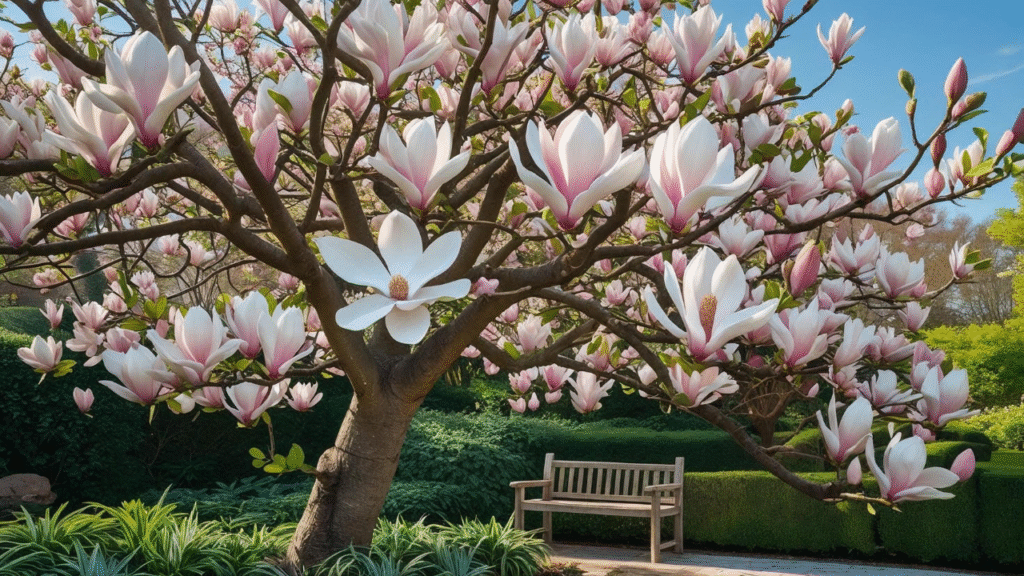
How to Grow and Care for a Butterfly Magnolia Tree: A Complete Guide for Beautiful Blooms
🌸 Imagine a tree in your garden that bursts into stunning white or pink blooms every spring, filling the air with a sweet fragrance. That’s the beauty of a butterfly magnolia tree! But like all trees, it requires the right care to thrive and reward you with breathtaking flowers year after year. If you’ve ever struggled to grow one or are simply looking to enhance its beauty, you’ve come to the right place.
In this guide, we’ll walk you through everything you need to know to ensure your butterfly magnolia tree not only survives but flourishes. Whether you’re a seasoned gardener or a beginner, our step-by-step tips will help you create the perfect environment for your tree, solve common problems, and encourage those beautiful blooms. Ready to turn your garden into a vibrant, floral haven? Keep reading! 🌱
Table of Contents
Toggle🌸✨ What Is a Butterfly Magnolia Tree? ✨🌸
The butterfly magnolia tree (Magnolia x loebneri) is a hybrid tree celebrated for its delicate and eye-catching blooms, which appear in early spring. Its unique flowers resemble butterfly wings, with soft white or pale pink petals that create a striking display. 🌿
This tree is a favorite among gardeners for its beauty and fragrance. It typically grows to a height of 15 to 20 feet, with a spread of 10 to 15 feet, making it perfect for small to medium-sized gardens. The butterfly magnolia tree is also known for its smooth, grayish bark and glossy, dark green leaves that turn yellow in the fall.
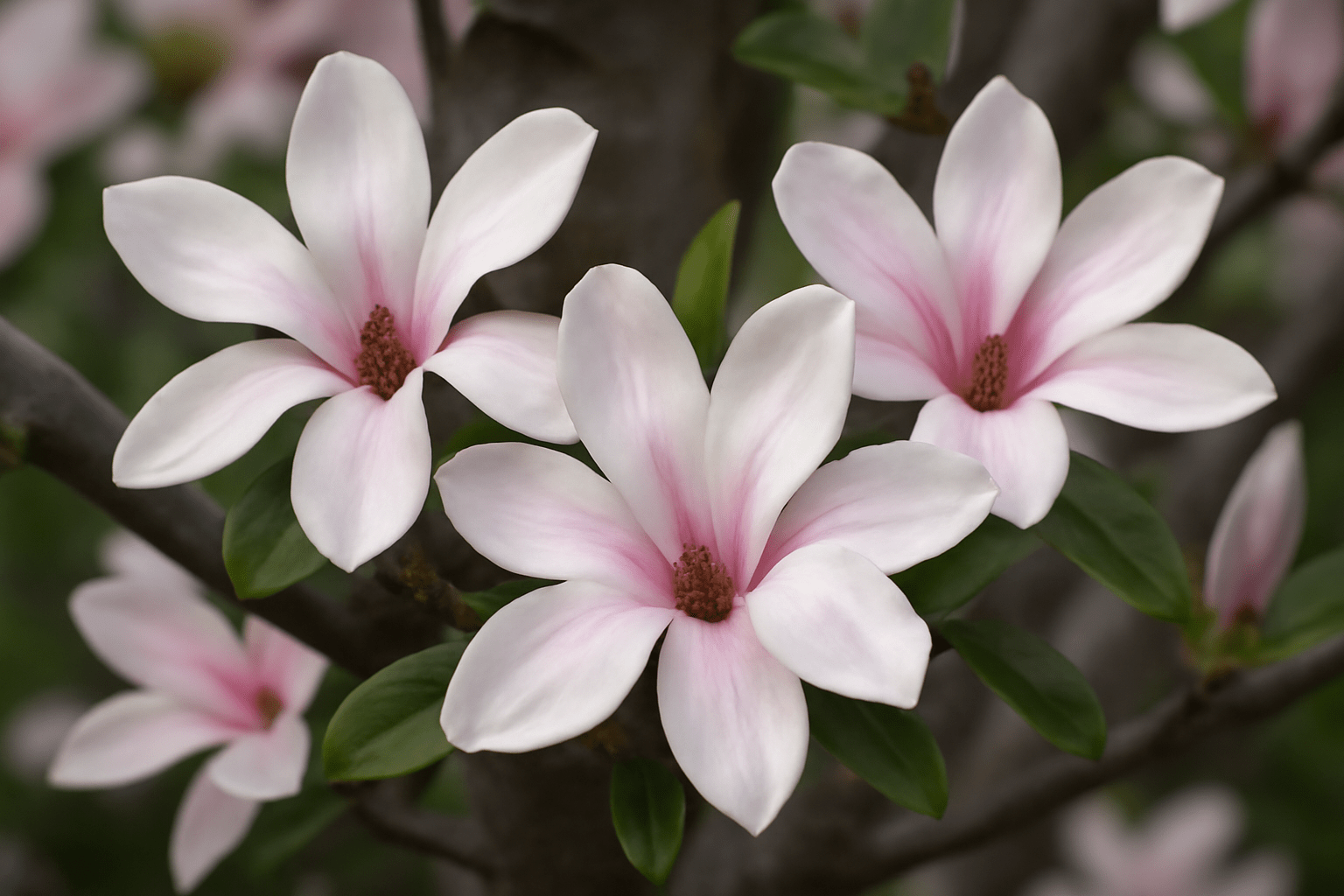
🌸 Why Choose a Butterfly Magnolia Tree? 🌸
If you’re looking to add a touch of elegance to your garden, the butterfly magnolia is the perfect choice. It’s not only aesthetically pleasing but also easy to maintain, making it an ideal option for beginners. 🌸 Plus, the tree’s early spring bloom means you’ll get to enjoy its beauty before many other plants even start to flower!
🌱 Hardiness Zones:
This tree thrives in USDA Hardiness Zones 4 to 8, meaning it can survive in a variety of climates, from chilly winters to warm summers. 🌞
Whether you’re a seasoned gardener or a newcomer, the butterfly magnolia tree can transform your landscape with its gorgeous, fragrant blooms—and with the right care, it can thrive in your garden for many years. 🌱
🌞🌿 Choosing the Right Location for Your Butterfly Magnolia Tree 🌿🌞
Selecting the perfect spot for your butterfly magnolia tree is crucial to its health and ability to thrive. A well-chosen location will give your tree the sunlight, space, and protection it needs to produce beautiful blooms every spring. Let’s break down the key factors you should consider when picking the ideal spot for your tree. 🌸
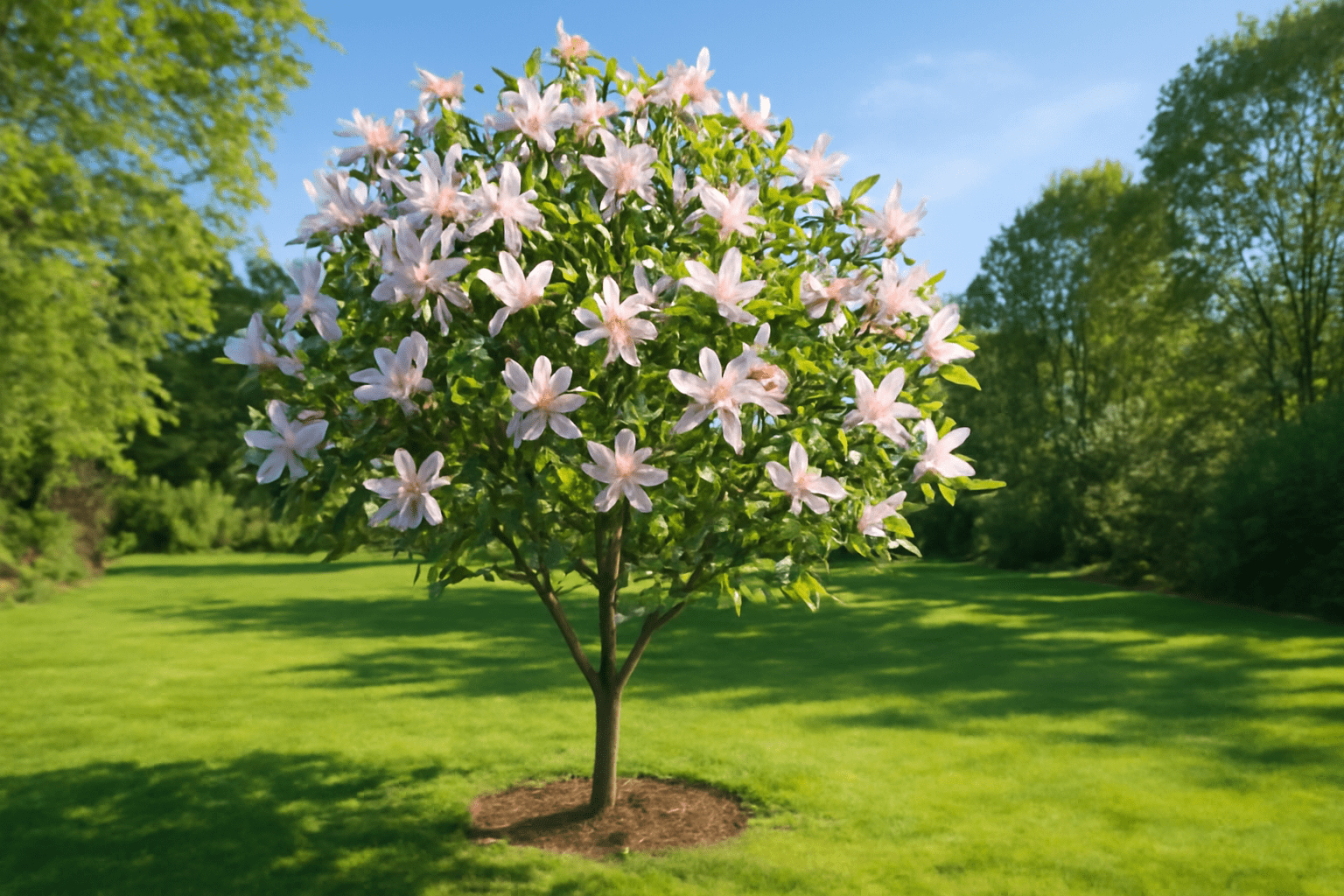
1. Sunlight Requirements 🌞
Butterfly magnolias love the sun! They thrive best when planted in full sun (at least 6 hours of direct sunlight per day). However, they can also tolerate partial shade (around 4 hours of sunlight), especially in hotter climates. 🌞 More sunlight means more blooms, so aim for a sunny location if possible.
2. Soil Preferences 🌱
These trees prefer well-drained, slightly acidic to neutral soil. The soil should not be too compacted, as it can lead to poor root growth. A loamy soil mix works wonders! 🌿 If your soil is heavy clay, consider mixing in organic matter like compost to improve drainage and soil structure.
Quick Tip: If you’re unsure about your soil’s pH, you can easily check it with a simple soil test kit, which is available at most garden centers.
3. Space Considerations 🌳
When choosing a location, keep in mind that butterfly magnolias need space to spread out. Ideally, plant your tree at least 10 feet away from buildings, fences, or other trees. This will give it enough room to grow both upward and outward. If you’re planting multiple trees, space them about 15 feet apart to ensure healthy growth and airflow.
4. Protection from Wind and Frost ❄️
While butterfly magnolias are quite hardy, they don’t like strong winds, which can damage the delicate blooms and branches. Try to plant your tree in a spot that is somewhat protected from harsh winds. Additionally, avoid planting in frost pockets (low areas where cold air settles) to protect your tree during the colder months.
Bonus Tip: Consider planting near a natural windbreak like a hedge or a row of taller trees to shield your butterfly magnolia from gusts.
By choosing a location with the right balance of sunlight, soil, space, and protection, you’ll set your butterfly magnolia tree up for success! 🌟 Now that you know where to plant it, you’re one step closer to enjoying those gorgeous spring blooms year after year. 🌸
🌱🌸 Planting Your Butterfly Magnolia Tree 🌸🌱
Now that you’ve chosen the perfect location, it’s time to plant your butterfly magnolia tree! 🌿 The planting process is straightforward, and with a little care, you can ensure that your tree starts its life in your garden strong and healthy. 🌸 Let’s walk through the simple steps to get your tree settled into its new home. 🌍
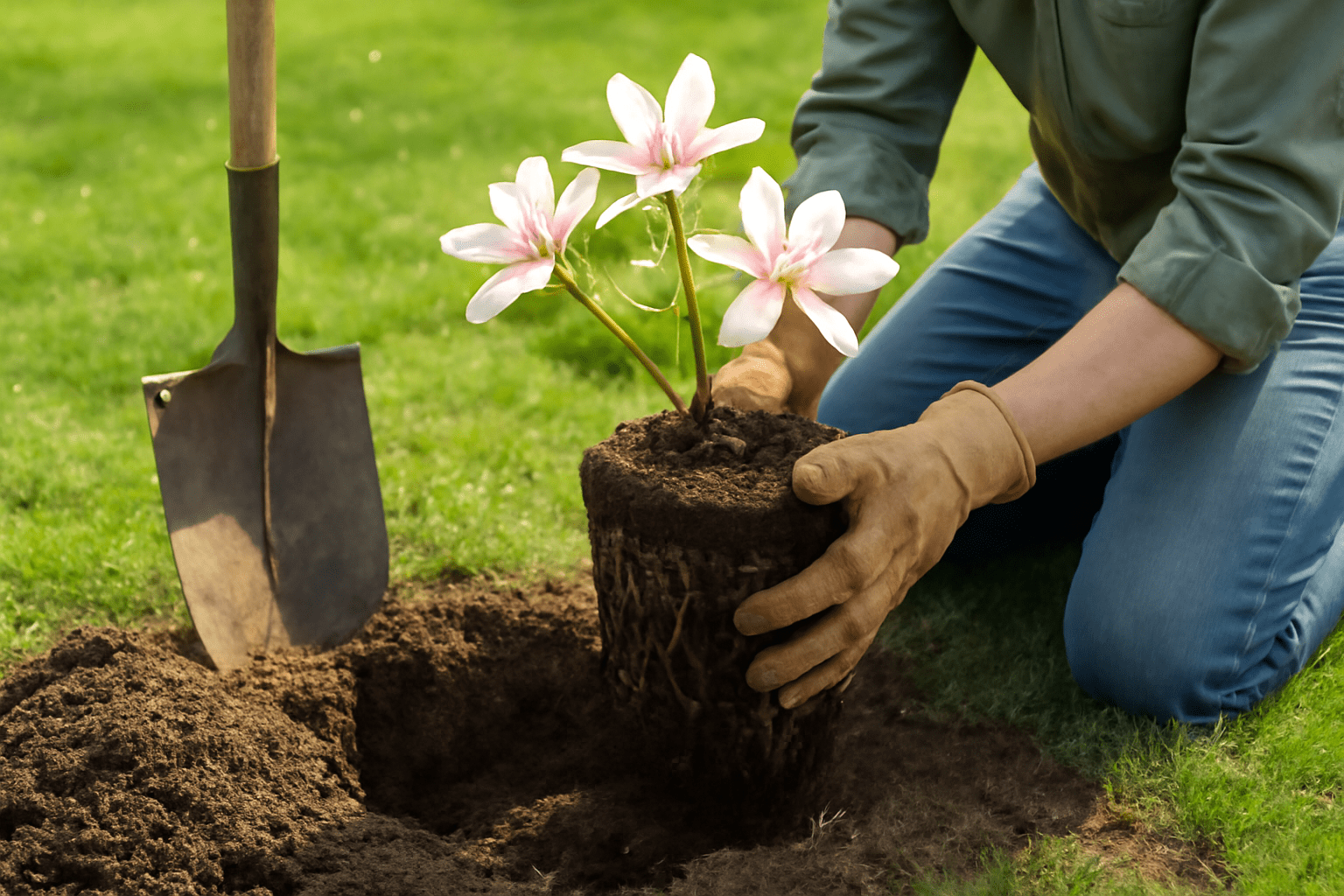
🌞 1. Choose the Right Time to Plant ⏰ 🌞
The best times to plant your butterfly magnolia tree are during early spring or fall. 🍂 These seasons provide mild weather, allowing the tree to establish its roots before the harsher summer 🌞 or winter ❄️ temperatures hit.
🌱 2. Digging the Hole 🕳️ 🌱
Start by digging a hole that’s about twice the width of the tree’s root ball 🌳 but no deeper than the root ball’s height. This gives the roots plenty of room to spread out 🌿. Make sure the hole is wide enough so the roots aren’t crowded, as cramped roots can stunt the tree’s growth. 🚫
Quick Tip: When planting in clay or compacted soil, make sure to break up the sides of the hole to allow the roots to penetrate easily. 🌱
🌿 3. Preparing the Tree 🌳 🌿
Gently remove your butterfly magnolia tree from its pot 🌿. Loosen the roots carefully with your hands if they are circling around the root ball 🌳. This will encourage the roots to grow outward into the soil 🌍. If the tree is balled and burlapped, remove the burlap and any wires around the root ball. ✂️
🌍 4. Planting the Tree 🌿 🌍
Place the tree in the hole, making sure the top of the root ball is level with the surrounding soil. 🌱 You don’t want the root ball to be buried too deep—this can lead to rot 💧. Position the tree so that it’s standing straight up 🏙️. Once it’s positioned correctly, backfill the hole with soil, gently packing it around the roots. 🏡
💦 5. Watering the Tree 💧 💦
Once the tree is in place, water thoroughly to settle the soil around the roots 🌱. Watering deeply ensures that the soil around the roots is evenly moist 💧 and helps eliminate air pockets in the soil. Keep the soil moist (but not soggy) during the tree’s first growing season 🌸 to help it establish a strong root system 🌳.
🍂 6. Mulching 🌾 🍂
Add a layer of mulch around the base of the tree, about 3 inches deep. 🌿 Mulch helps retain moisture 💧, suppress weeds 🌱, and regulate soil temperature 🌡️. Keep the mulch a few inches away from the tree trunk to prevent rot 🍂.
Quick Recap:
- Dig a hole twice the width of the root ball 🌱.
- Place the tree at the same level as it was in the pot 🌳.
- Water deeply to settle the soil 💦.
- Add mulch around the base to conserve moisture 🌸.
By following these simple steps, you’re giving your butterfly magnolia tree the best possible start 🌟. With the right care, it will grow strong 🌳 and bloom beautifully year after year 🌸.
💧🌱 Watering and Fertilizing Your Butterfly Magnolia Tree 🌱💧
To ensure your butterfly magnolia tree thrives and blooms year after year, proper watering and fertilizing are essential. 🌸 These two key elements will help your tree establish a strong root system and encourage lush growth and vibrant flowers. Let’s dive into the best practices for keeping your tree healthy and happy! 🌿
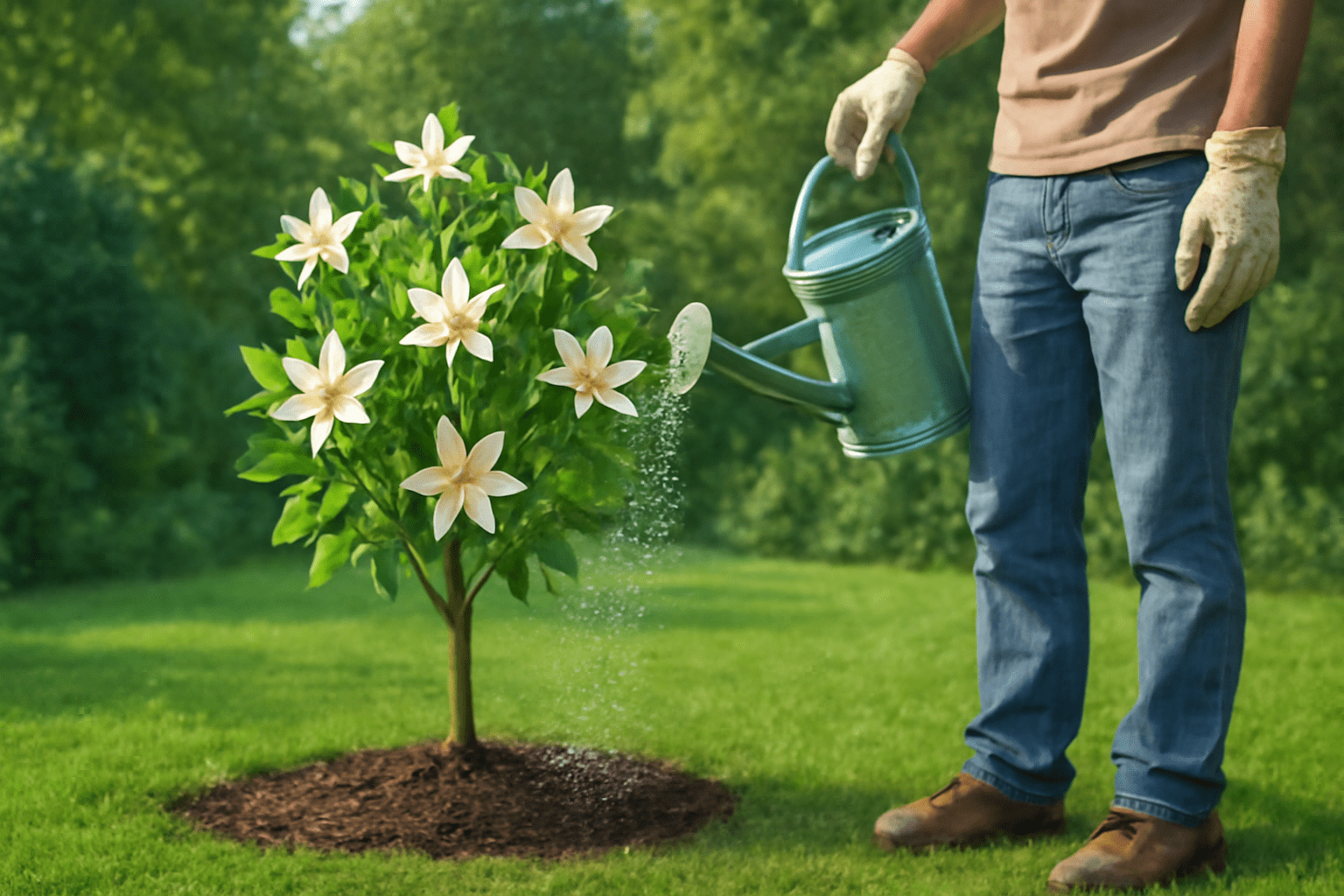
💦 1. Watering Your Butterfly Magnolia Tree 💧
Proper watering is crucial, especially during the first few years of your tree’s life 🌱. Here’s how to water effectively:
Deep Watering: Butterfly magnolias prefer deep, thorough watering rather than frequent shallow watering. 🌳 This encourages the roots to grow deep into the soil, making the tree more resilient in the long term.
How Often to Water: Water the tree once a week during the growing season 🌞, ensuring the soil is moist but not waterlogged. In the first year, you may need to water more often during hot and dry spells 🌞. Once the tree is established, you can reduce watering frequency.
Check Soil Moisture: Always check the soil before watering. If the top 1-2 inches of soil are dry 🌾, it’s time to water 💦. If it’s still moist, hold off 🚫. Overwatering can lead to root rot, so aim for a balanced, consistent level of moisture.
Quick Tip: Mulching around the base of the tree 🌱 will help retain moisture 💧 and reduce the need for frequent watering.
🌿 2. Fertilizing Your Butterfly Magnolia Tree 🌳
Fertilizing helps your tree grow strong and healthy 🌿, promoting more blooms and vibrant leaves 🍃. Here’s how to fertilize your butterfly magnolia tree correctly:
When to Fertilize: Apply fertilizer in early spring 🌸, just before the tree starts to bloom. This timing will give it the nutrients it needs for the growing season 🌞. You can fertilize again in late spring if desired, but it’s not necessary.
Type of Fertilizer: Choose a slow-release, balanced fertilizer (such as a 10-10-10 formula) to support healthy growth 🌱. Avoid fertilizers with high nitrogen content 🌿, as they can promote excessive leaf growth at the expense of blooms 🌸. For even better results, consider using a fertilizer specially formulated for trees 🌳.
How to Apply: Spread the fertilizer evenly around the tree’s base 🌍, starting a few inches away from the trunk and extending to the drip line (the edge of the tree’s canopy). Water the tree thoroughly 💧 after applying the fertilizer to help it absorb the nutrients 🌱.
Quick Tip: If your tree is planted in poor soil 🌍, consider amending the soil with compost or organic matter before fertilizing 🌾. This will improve soil structure and nutrient retention 🌱.
🌷 Quick Recap:
- Water deeply once a week 💦, checking soil moisture before watering 🌱.
- Fertilize in early spring 🌸 with a balanced, slow-release fertilizer 🌿.
- Mulch around the tree 🍂 to conserve moisture and reduce watering needs 💧.
By following these simple watering and fertilizing tips 🌸, you’ll set your butterfly magnolia tree up for strong growth 🌳 and a gorgeous display of blooms 🌼. Healthy roots and well-fed soil are the keys to a beautiful tree 🌱 that will continue to bloom season after season! 🌷
✂️🌳 Pruning and Shaping Your Butterfly Magnolia Tree 🌳✂️
Pruning your butterfly magnolia tree is an essential part of its care routine 🌱. Regular pruning helps maintain its shape, encourages healthy growth, and ensures a beautiful, vibrant display of blooms each year 🌸. Let’s explore the best practices for pruning and shaping your tree in a way that promotes longevity and beauty 🌿.

🌱 1. When to Prune Your Butterfly Magnolia Tree 🌿
The best time to prune your butterfly magnolia tree is late winter to early spring 🌸, just before the tree starts to show new growth. This timing ensures you won’t damage any of the developing buds 🌿 and gives the tree a head start for the growing season 🌱.
Quick Tip: Avoid pruning during the summer 🌞, as this can stress the tree and reduce bloom production 🌸. If necessary, light pruning for maintenance can be done after the blooms fade 🌿.
✂️ 2. What to Prune 🌳
When pruning, focus on removing any dead, damaged, or diseased branches 🌿. These can hinder the tree’s growth and become a breeding ground for pests or diseases 🦠. You should also remove any crossing or inward-growing branches, which can interfere with airflow and sunlight penetration 🌞.
Key Areas to Focus On:
- Dead or Damaged Wood: These branches are more vulnerable to pests and diseases 🦠. Remove them to keep the tree healthy 🌱.
- Suckers and Water Sprouts: These growths appear around the base and can drain energy from the tree 🌳. Remove them early to encourage strong, healthy growth 🌱.
- Overgrown or Overlapping Branches: Thin out crowded areas to allow light 🌞 and air 💨 to reach the inner branches, promoting better health and more blooms 🌸.
🌿 3. How to Prune ✂️
Tools: Use sharp, clean pruning shears ✂️ for smaller branches and a pruning saw 🪚 for thicker branches. Make sure your tools are disinfected 🧴 before use to prevent spreading disease.
Pruning Technique: Always make clean cuts at a slight angle just above a bud or branch junction 🌿. This helps the tree heal faster and reduces the risk of disease 🦠.
Quick Tip: When removing larger branches, make the cut in sections ✂️ to avoid tearing the bark 🌳. Start by cutting from the underside of the branch to prevent it from snapping 🌿.
🌳 4. Shaping Your Tree 🌿
While pruning is about removing unnecessary or unhealthy growth, shaping your butterfly magnolia tree helps maintain a balanced, aesthetically pleasing form 🌸. You can shape the tree to enhance its natural structure or remove any uneven growth 🌱.
Encourage a Central Leader: Aim to develop a strong central stem (leader) with evenly spaced branches 🌳. This helps the tree maintain an attractive, symmetrical shape 🌱.
Light Shaping: Gently trim the outer branches 🌿 to encourage a rounded shape without over-pruning ✂️. This ensures the tree remains full and lush 🌸 while maintaining a compact size 🌱.
🌷 Quick Recap:
- Prune in late winter or early spring 🌸 before new growth starts 🌱.
- Remove dead, damaged, or diseased branches ✂️ to maintain tree health 🌿.
- Shape the tree by encouraging a strong central leader and thinning crowded branches 🌳.
- Use clean, sharp tools for precise cuts 🌿.
Pruning and shaping your butterfly magnolia tree might seem like a small task 🌱, but it has a big impact on its health 🌿, bloom quality 🌸, and overall appearance 🌷. With the right care, your tree will remain strong, balanced, and beautifully bloomed every spring! 🌸
⚠️🌿 Common Problems and How to Solve Them 🌿⚠️
Even though the butterfly magnolia tree is a relatively low-maintenance and hardy plant 🌱, it can still encounter a few challenges along the way. Whether it’s pests 🐞, diseases 🦠, or environmental factors 🌍, understanding these issues and how to address them will help keep your tree healthy 🌳 and blooming beautifully 🌸. Let’s look at some of the most common problems and practical solutions! 🌿
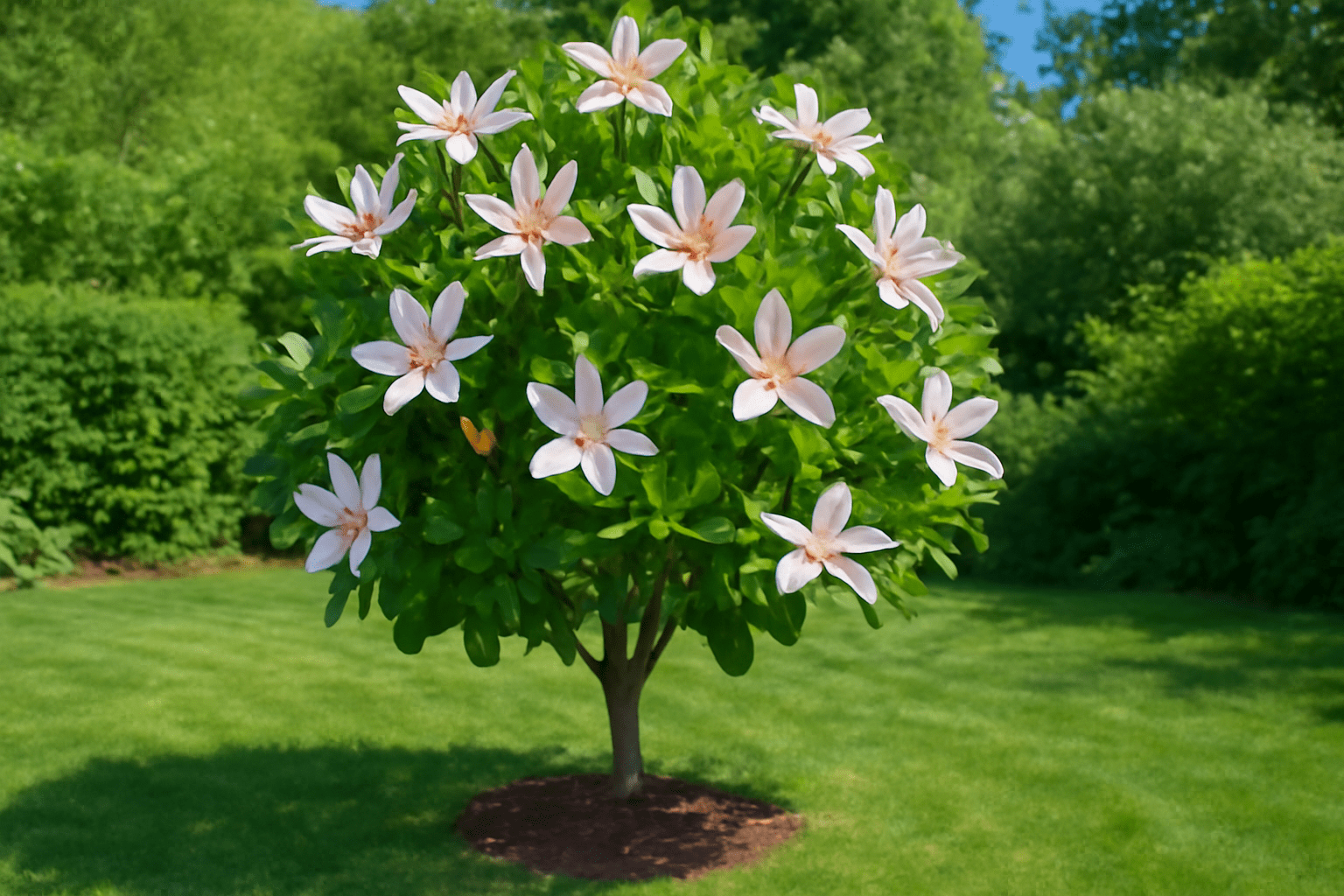
🐞 1. Pests and Insects 🐛
While butterfly magnolia trees are generally pest-resistant, they can still attract a few unwanted visitors 🦗, including aphids, scales, and caterpillars 🐛.
- Aphids: These tiny insects can cause damage by sucking the sap from the leaves 🍃, leading to yellowing and stunted growth 🌱.
Solution: Use insecticidal soap 🧴 or a strong stream of water 💦 to wash aphids off the tree 🌳. Natural predators like ladybugs 🐞 can also help keep aphid numbers in check. - Scale Insects: Scale can appear as small, hard lumps on the leaves 🍃 and stems. They suck sap, weakening the tree 🌱.
Solution: Treat with neem oil 🌿 or an insecticidal soap 🧴. Scrape the scales off by hand ✋ if the infestation is small. - Caterpillars: These pests feed on leaves 🌿 and buds 🌸, potentially damaging the tree’s appearance and health.
Solution: Hand-pick caterpillars off the tree ✋ or use Bt (Bacillus thuringiensis), a natural pest control option 🌱.
🌱 2. Diseases 🦠
Your butterfly magnolia tree might also be susceptible to certain diseases. The most common include powdery mildew 🦠 and root rot 🌱.
- Powdery Mildew: This fungal disease creates a white, powdery coating on leaves 🍃, affecting photosynthesis 🌞 and overall tree health 🌱.
Solution: Prune infected leaves ✂️, increase air circulation 💨 around the tree 🌳, and apply fungicide if necessary 🧴. Keeping the tree in a sunny location 🌞 will help prevent this issue. - Root Rot: Overwatering 💧 or poorly-drained soil 🌍 can lead to root rot, which suffocates the tree’s roots and can kill it ⚰️.
Solution: Make sure the tree is planted in well-draining soil 🌱 and avoid overwatering 💦. If you suspect root rot, replant the tree 🌳 in a new location with better drainage or amend the soil with organic matter 🌿.
🌼 3. Non-Blooming Tree 🌸
One of the most frustrating issues for gardeners is when a butterfly magnolia tree doesn’t bloom 🌱. If your tree is not producing flowers 🌸, it might be due to several factors:
- Lack of Sunlight: These trees need full sun 🌞 for at least 6 hours a day to bloom properly.
Solution: Ensure your tree is in a sunny spot 🌞. If it’s shaded 🌳, consider pruning nearby trees 🌲 or shrubs 🌿 to allow more light to reach the magnolia 🌸. - Improper Pruning: Over-pruning ✂️, especially cutting too many buds or branches 🌱, can reduce flowering 🌸.
Solution: Avoid heavy pruning, and focus only on removing dead or damaged wood 🌳. Prune sparingly ✂️, especially right before the bloom period 🌸. - Nutrient Deficiency: A lack of essential nutrients 🌱, like phosphorus, can also lead to poor blooming 🌼.
Solution: Fertilize the tree 🌳 with a balanced fertilizer 🌿 that supports flower production 🌸. A phosphorus-rich fertilizer is especially helpful 🧴.
🍂 4. Yellowing Leaves 🌿
If your tree’s leaves are turning yellow 🍂, it could be a sign of several different issues 🦠.
- Overwatering 💧 or Poor Drainage 🌍: Too much water can lead to yellowing leaves 🍃, often accompanied by wilting.
Solution: Check the soil moisture regularly 💧. If the soil is too wet, improve drainage 🌱 or reduce watering 💦. Ensure the tree is planted in well-draining soil 🌍. - Nutrient Deficiency 🌿: A lack of nitrogen, iron, or other nutrients can cause yellowing 🍂.
Solution: Fertilize the tree 🌳 with a balanced, slow-release fertilizer 🌱. Adding organic compost 🌿 to the soil can also help improve nutrient levels.
🌸 Quick Recap:
- Pests: Use insecticidal soap 🧴 or neem oil 🌿 for aphids, scales, and caterpillars 🐛.
- Diseases: Prune affected areas ✂️ and apply fungicide 🧴 for powdery mildew, and ensure good drainage 🌍 to avoid root rot 🌱.
- Non-blooming: Ensure your tree gets enough sunlight 🌞, prune sparingly ✂️, and use the right fertilizer 🌸.
- Yellowing Leaves: Avoid overwatering 💧, improve drainage 🌍, and consider fertilizing 🌿 with balanced nutrients 🌱.
By addressing these common issues with quick, practical solutions 🌿, you can ensure your butterfly magnolia tree 🌳 stays healthy, strong 💪, and continues to produce stunning blooms 🌸 year after year!
🌸✨ Extending the Blooming Period and Enhancing Flower Quality ✨🌸
One of the most rewarding aspects of a butterfly magnolia tree 🌳 is its beautiful spring blooms 🌸. However, with a little extra care, you can extend the blooming period and enhance the quality of those stunning flowers 🌷. Here’s how to make sure your tree not only blooms beautifully but continues to impress for longer! 🌿
🌼 1. Deadheading Spent Flowers 🌸
Deadheading, or removing spent blooms, is a simple yet effective way to encourage more blooms and maintain the tree’s visual appeal 🌿.
- Why Deadhead? Deadheading helps the tree direct its energy toward producing new flowers 🌸 rather than spending resources on seed production 🌱.
- How to Deadhead: As soon as the flowers start to fade, use clean, sharp pruners ✂️ to cut off the flower heads at the base of the stem, just above the first set of healthy leaves 🍃.
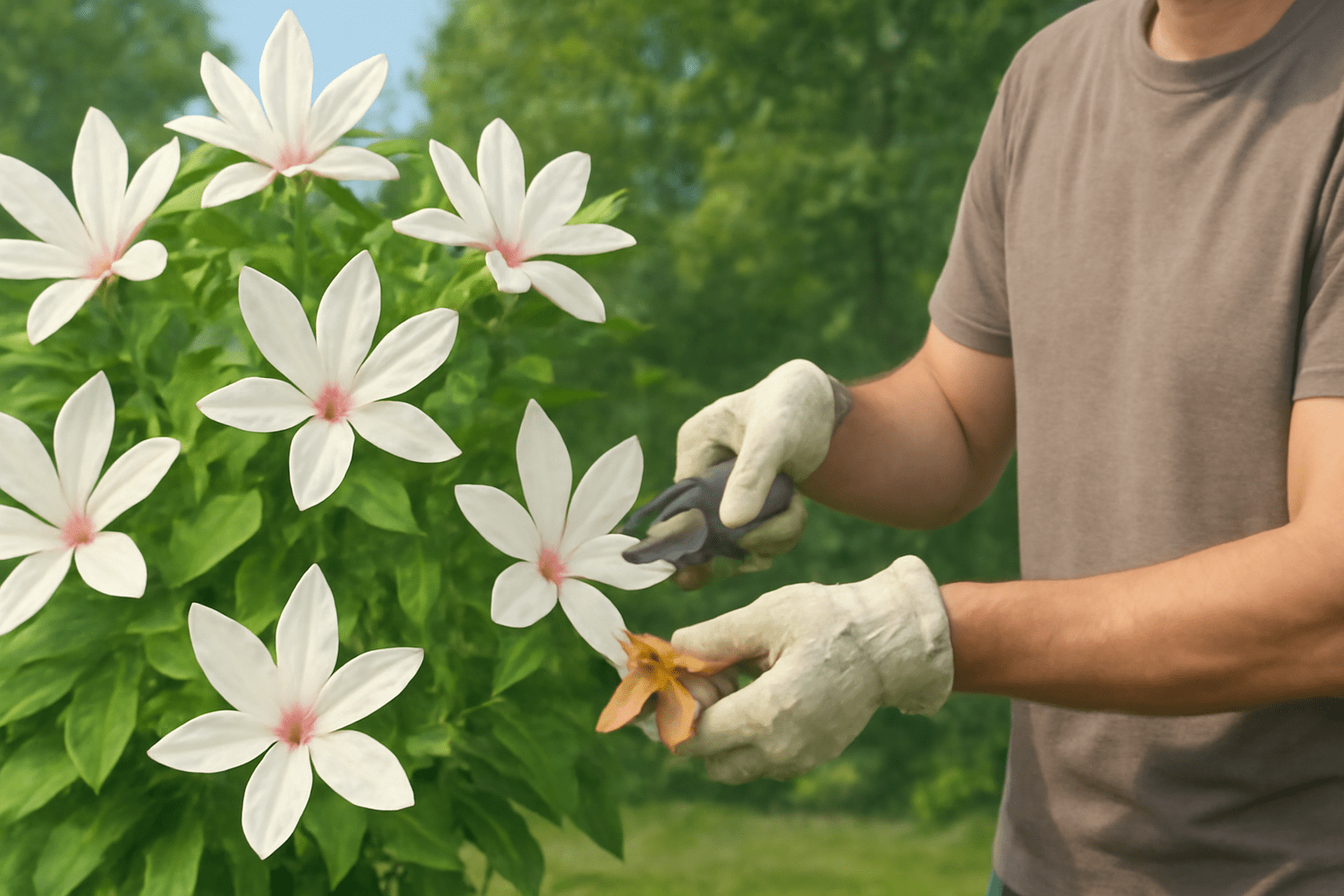
Quick Tip: Deadheading will not only encourage more blooms 🌸 but also improve the overall look of your tree 🌿, keeping it neat and tidy throughout the blooming season.
🌿 2. Proper Nutrition for More Vibrant Blooms 🌱
To support long-lasting, high-quality blooms 🌸, it’s crucial to feed your butterfly magnolia tree with the right nutrients 🧴.
- Phosphorus-Rich Fertilizer: Phosphorus is essential for promoting flower development 🌷. Using a phosphorus-rich fertilizer will encourage more vibrant blooms 🌸.
- Slow-Release Fertilizer: Opt for a slow-release fertilizer 🌱 that will provide consistent nutrition throughout the growing season 🌿. This ensures that your tree has the nutrients it needs at the right time.
Quick Tip: Fertilize in early spring 🌸 just before the blooming period begins 🌱 to give your tree a boost for the upcoming flowers 🌷. Avoid over-fertilizing, as this can lead to excessive leaf growth 🌿 at the expense of flowers 🌸.
💧 3. Consistent Watering During Bloom Time 🌸
Keeping your tree well-watered during its bloom period 🌱 is essential for ensuring high-quality flowers 🌸. Consistent moisture helps the tree stay healthy 🌿 and supports optimal flower production 🌷.
- Water Deeply: Water deeply and infrequently 🌊 rather than shallowly. This encourages deep root growth 🌱, which is essential for overall tree health 🌿 and better blooms 🌸. Aim for about 1 inch of water 💧 per week.
- Avoid Overwatering: While consistent watering is important 🌿, be cautious not to overwater 💦, as soggy soil 🌍 can lead to root rot 🦠 and other issues.
Quick Tip: If you’re in a dry spell during the blooming period, consider using a soaker hose 🌊 or watering at the tree’s base to ensure deep penetration of water 💧.
🌞 4. Provide Ideal Growing Conditions 🌿
Your butterfly magnolia tree 🌳 will produce the best flowers 🌸 when it’s planted in the right environment 🌱. Here’s what to keep in mind:
- Full Sunlight: Ensure your tree is planted in full sun 🌞 (at least 6 hours of direct sunlight 🌞 per day). More sunlight means more energy 🌿 for the tree to produce beautiful blooms 🌸.
- Protection from Wind and Frost: While the butterfly magnolia is hardy 🌳, extreme weather 🌪️ can harm the blooms 🌸. Consider planting your tree in a location that is protected from strong winds 🌬️ and frost ❄️, especially early in the spring when the blooms are most delicate 🌸.
✂️ 5. Prune for Better Airflow and Sunlight 🌞
Proper pruning not only keeps your tree in shape 🌳 but also ensures that the flowers receive ample light 🌞 and air circulation 💨.
- Thin Out Dense Areas: Lightly prune any overcrowded branches 🌿, especially in the center of the tree 🌳, to allow more sunlight ☀️ and air 💨 to reach the flowers 🌸. This helps the blooms grow larger 🌷 and last longer 🌼.
Quick Tip: Always prune after the bloom period 🌸 to avoid cutting off potential flower buds for the following year 🌱.
🌷 Quick Recap:
- Deadhead spent flowers 🌸 to promote more blooms 🌿 and improve appearance 🌱.
- Fertilize with a phosphorus-rich, slow-release fertilizer 🌸 to encourage vibrant flowers 🌷.
- Water deeply and consistently 💧 during bloom season 🌸 to support healthy flowers 🌿.
- Ensure full sunlight 🌞 and protect from wind 🌬️ and frost ❄️ for the best bloom quality 🌸.
- Prune carefully ✂️ to ensure good airflow 💨 and sunlight 🌞 for optimal flowering 🌷.
By following these tips 🌿, you can extend your butterfly magnolia tree’s bloom period 🌸 and enhance the quality of its flowers 🌷, ensuring that every spring brings a stunning display of beauty 🌼. With proper care 🌱, your tree will reward you with breathtaking blooms 🌸 year after year! 🌷
🌟🌳 Final Thoughts 🌳🌟
Caring for a butterfly magnolia tree 🌳 is not only about enhancing your garden’s beauty 🌸—it’s about creating a vibrant, living centerpiece 🌿 that brings joy 😊 and fragrance 🌸 every spring. With the right care 🌱, attention, and a little patience ⏳, your tree will flourish 🌳, producing stunning blooms 🌸 that will brighten your landscape year after year 🌞.
Remember, from choosing the perfect location 📍 to watering 💧, fertilizing 🌿, and pruning ✂️, each step plays a crucial role in ensuring your tree thrives 🌱. Whether you’re a seasoned gardener 🌿 or just getting started 🌱, the tips and techniques outlined in this guide 📘 will help you build a strong, healthy butterfly magnolia tree 🌸 that’s sure to be the envy of your neighborhood 🏡.
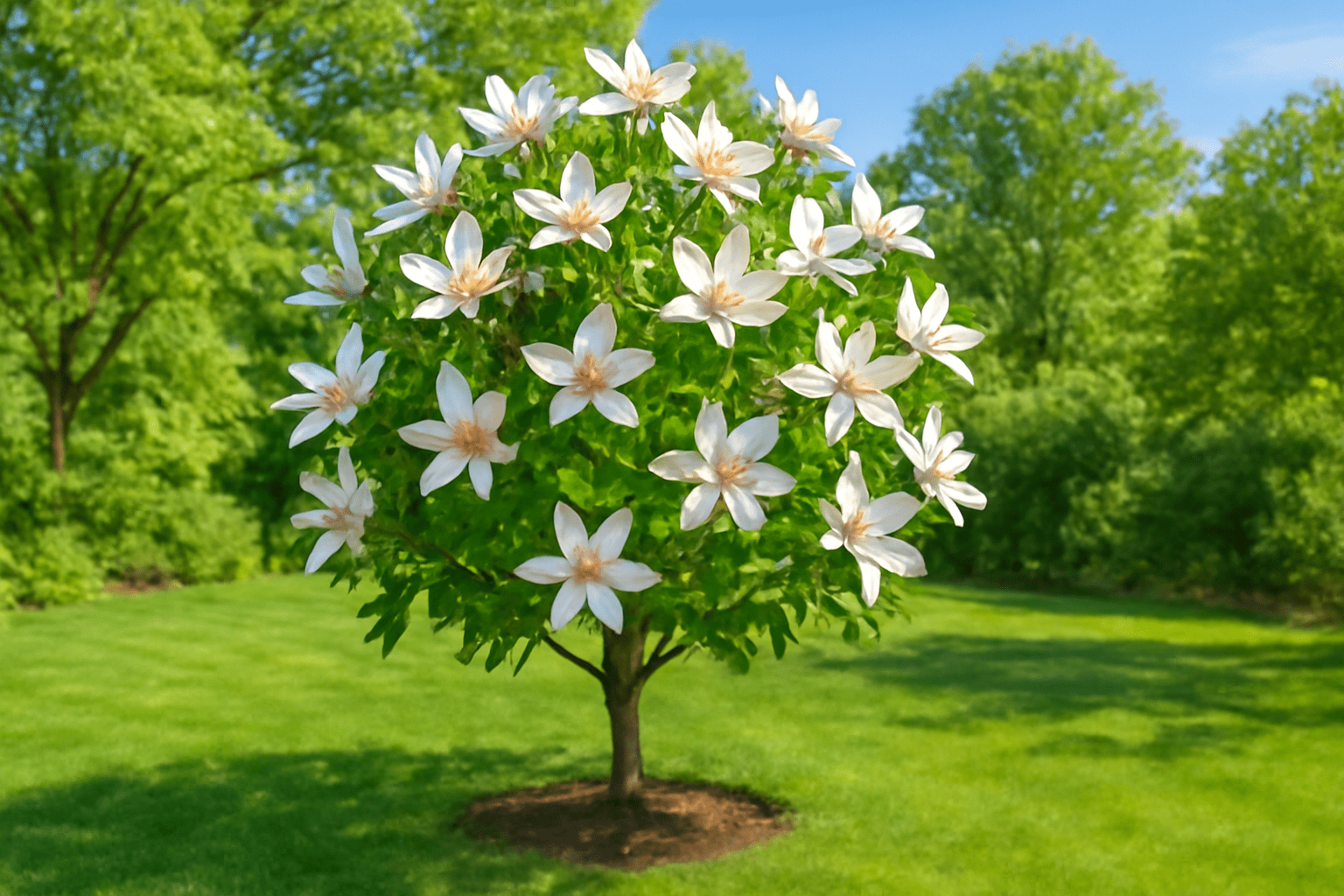
So go ahead—plant your butterfly magnolia 🌳, nurture it with love 💚, and watch it reward you with a breathtaking floral display 🌼 each season 🌿. Happy gardening! 🌺🌸
Frequently Asked Questions (FAQ)
What is the best time to plant a butterfly magnolia tree?
The ideal time to plant a butterfly magnolia tree is during early spring or fall. These seasons offer mild temperatures, allowing the tree to establish its roots before the harsher summer or winter conditions set in.
How much sunlight does a butterfly magnolia tree need?
Butterfly magnolias thrive in full sun (at least 6 hours of direct sunlight per day), but they can tolerate partial shade in warmer climates. More sunlight encourages better blooms, so aim for a sunny spot if possible.
How often should I water my butterfly magnolia tree?
Water your butterfly magnolia tree once a week during the growing season, ensuring deep watering. During hot or dry spells, you may need to water more often, but always check the soil moisture to avoid overwatering.
Why isn’t my butterfly magnolia tree blooming?
If your butterfly magnolia isn’t blooming, it could be due to lack of sunlight, improper pruning, or nutrient deficiencies. Ensure it gets at least 6 hours of sunlight daily, prune lightly, and fertilize with a balanced, phosphorus-rich fertilizer to encourage blooms.
How do I prune my butterfly magnolia tree?
Prune your tree in late winter to early spring, before new growth begins. Focus on removing dead or damaged branches, and thin out overcrowded areas to improve airflow and sunlight penetration, which helps with overall health and bloom production.
What type of soil does a butterfly magnolia tree prefer?
Butterfly magnolias prefer well-drained, slightly acidic to neutral soil. Loamy soil works best, and if your soil is heavy or clay-like, mix in organic matter or compost to improve drainage.
How can I extend the blooming period of my butterfly magnolia tree?
To extend the blooming period, deadhead spent flowers, fertilize with a phosphorus-rich fertilizer, and ensure the tree gets consistent deep watering during its bloom period. These practices will encourage more blooms and enhance flower quality.
Can I grow a butterfly magnolia tree in a pot?
Yes, you can grow a butterfly magnolia tree in a pot, but it’s important to choose a large pot with proper drainage. Make sure the tree receives adequate sunlight, and be prepared to water more frequently since containers dry out faster than the ground.
